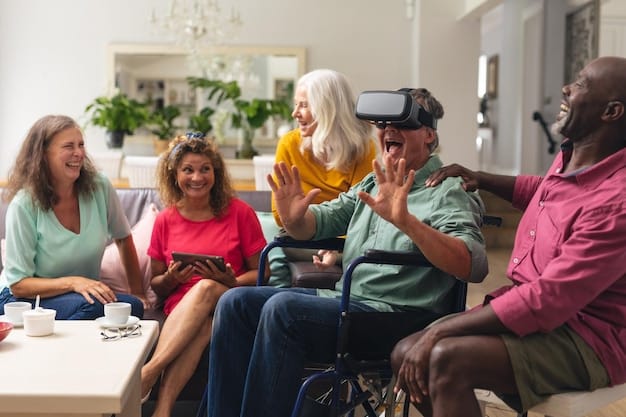AI and Accessibility: Empowering People with Disabilities Through Tech

AI and accessibility converge to create solutions that significantly improve the lives of people with disabilities, offering tools and technologies that enhance independence, communication, and access to information and opportunities.
The intersection of AI and accessibility is unlocking unprecedented opportunities for people with disabilities, creating a more inclusive and equitable world through technological innovation.
The Promise of AI for Accessibility
Artificial intelligence is rapidly transforming various aspects of our lives, and its potential to enhance accessibility for people with disabilities is particularly promising. AI-powered tools and technologies are enabling individuals to overcome barriers and participate more fully in society.
From automated captioning and translation to personalized learning experiences, AI is opening doors to new possibilities for communication, education, employment, and independent living. Let’s delve into the specific ways AI is revolutionizing accessibility.

AI-Powered Assistive Technologies
One of the most impactful applications of AI in accessibility is the development of assistive technologies. These tools leverage AI algorithms to provide real-time support and personalized assistance to individuals with various disabilities.
- Screen Readers: AI-enhanced screen readers can convert text to speech with improved accuracy and natural-sounding voices, making digital content accessible to people with visual impairments.
- Voice Recognition Software: AI-powered voice recognition allows individuals with motor impairments to control devices, dictate text, and navigate digital interfaces using their voice.
- Smart Glasses: AI-enabled smart glasses can provide real-time visual assistance, such as object recognition, scene descriptions, and navigation guidance, for people with visual impairments.
These technologies are not only improving the quality of life for people with disabilities but also fostering greater independence and self-sufficiency.
Enhancing Communication Through AI
Communication is a fundamental aspect of human interaction, and AI is playing a crucial role in breaking down communication barriers for people with disabilities. AI-powered tools are providing new ways to connect, express themselves, and access information.
These advancements are fostering greater understanding and inclusion, allowing individuals to participate more fully in social and professional settings.
Real-Time Translation and Captioning
AI-powered translation and captioning services are making communication more accessible for people who are deaf, hard of hearing, or speak different languages. These technologies provide real-time transcriptions and translations of spoken words, enabling individuals to follow conversations, lectures, and presentations with ease.
AI-based solutions can also generate captions for videos and live streams, making multimedia content accessible to a wider audience.
AI-Driven Speech Synthesis
Speech synthesis technologies have come a long way, thanks to advancements in AI. AI-driven speech synthesis can generate realistic and expressive voices that can be used by individuals who have difficulty speaking or have lost their voice due to medical conditions.
These technologies enable individuals to communicate their thoughts and ideas in a clear and effective manner, fostering greater autonomy and participation.

AI in Education: Creating Inclusive Learning Environments
Education is a cornerstone of personal and professional development, and AI is revolutionizing the way people with disabilities access and engage with learning materials. AI-powered tools are creating more inclusive and personalized learning environments that cater to individual needs and learning styles.
By adapting content, providing customized support, and promoting accessibility, AI is empowering students with disabilities to reach their full potential.
Personalized Learning Experiences
AI algorithms can analyze student data to identify individual learning needs and preferences. This information can be used to create personalized learning experiences that adapt to each student’s pace, style, and level of understanding.
- Adaptive Learning Platforms: AI-powered platforms can adjust the difficulty level of learning materials based on student performance, ensuring that each student is challenged appropriately.
- Personalized Feedback: AI can provide students with targeted feedback on their work, helping them identify areas for improvement and develop their skills.
- Accessible Content Creation: AI tools can assist educators in creating accessible learning materials, such as alternative text descriptions for images and captions for videos.
Through personalized learning, educators can better meet the needs of all students, fostering a more inclusive and equitable learning environment.
AI and Employment: Opening Doors to Opportunities
Employment is a crucial aspect of economic and social inclusion, and AI is helping to break down barriers and create new opportunities for people with disabilities. AI-powered tools are assisting individuals in finding jobs, performing tasks, and advancing their careers.
These advancements are not only benefiting individuals but also contributing to a more diverse and productive workforce.
AI-Enhanced Job Search and Matching
AI algorithms can analyze job postings and candidate profiles to identify the best matches based on skills, experience, and interests. This can help people with disabilities find jobs that are well-suited to their abilities and career goals.
AI can also assist in creating accessible resumes and cover letters, highlighting the skills and qualifications of individuals with disabilities.
Assistive Tools for the Workplace
AI-powered tools are also helping people with disabilities perform tasks in the workplace. From voice-controlled software to robotic assistants, these technologies are enabling individuals to overcome physical and cognitive limitations and contribute their skills and talents to the workforce.
AI can also assist in creating accessible workspaces, ensuring that individuals with disabilities have the tools and resources they need to succeed.
Navigating Daily Life with AI
Beyond specific applications in education, employment, and communication, AI is also impacting the daily lives of people with disabilities in countless ways. From smart home devices to AI-powered transportation solutions, technology is providing new levels of independence and convenience.
These advancements are helping individuals to live more fulfilling and autonomous lives, participating more fully in their communities.
Smart Home Automation
AI-powered smart home devices can automate tasks such as controlling lights, adjusting thermostats, and operating appliances. This can be particularly beneficial for individuals with mobility impairments, allowing them to manage their homes with greater ease.
- Voice-Controlled Assistants: AI assistants like Amazon Alexa and Google Assistant can be used to control smart home devices, access information, and perform a variety of tasks using voice commands.
- Smart Sensors: AI-enabled sensors can detect changes in the environment, such as falls or unusual activity, and automatically alert caregivers or emergency services.
- Personalized Automation: AI can learn an individual’s preferences and routines, automating tasks based on their specific needs and habits.
Through smart home automation, people with disabilities can enjoy greater independence and control over their living environments.
The Future of AI and Accessibility
As AI technology continues to evolve, its potential to transform accessibility for people with disabilities will only grow. From more sophisticated assistive technologies to personalized learning and employment solutions, AI promises to create a more inclusive and equitable world for all.
However, it is important to address the ethical considerations and potential challenges that may arise as AI becomes more prevalent in accessibility. Ensuring fairness, transparency, and accountability will be crucial to realizing the full potential of AI for empowering people with disabilities.
| Key Point | Brief Description |
|---|---|
| ♿ AI Assistive Tech | AI powers screen readers, voice recognition, and smart glasses. |
| 🗣️ Communication | AI enables real-time translation, captioning, and speech synthesis. |
| 📚 Inclusive Education | AI personalizes learning, adapts content, and provides feedback. |
| 🏢 Workplace AI | AI aids job searches, matches skills, and offers workplace assistance. |
FAQ
▼
AI improves screen reader accuracy through machine learning, providing natural-sounding voices and enhanced interpretation of digital content. This makes online information more accessible and easier to understand.
▼
AI personalizes education by tailoring content to individual student needs, offering adaptive learning platforms, and providing customized feedback, fostering a more inclusive and effective learning experience.
▼
AI voice recognition allows individuals with motor impairments to control devices, dictate text, and navigate interfaces hands-free, enhancing their autonomy and participation in digital activities.
▼
AI facilitates communication through real-time translation and captioning services, making spoken conversations, lectures, and multimedia content accessible to people who are deaf or hard of hearing.
▼
AI helps by matching skills to job postings, creating accessible resumes, and offering assistive tools in the workplace, thereby improving employment prospects for individuals with disabilities.
Conclusion
The integration of AI into accessibility technologies is revolutionizing the lives of people with disabilities, fostering greater independence, inclusion, and opportunity. As AI continues to evolve, it holds the potential to further transform accessibility and create a more equitable world for all.





